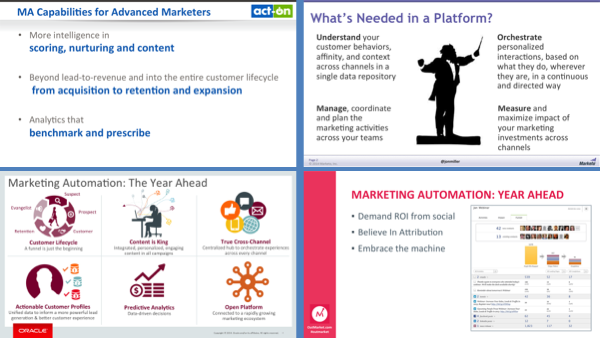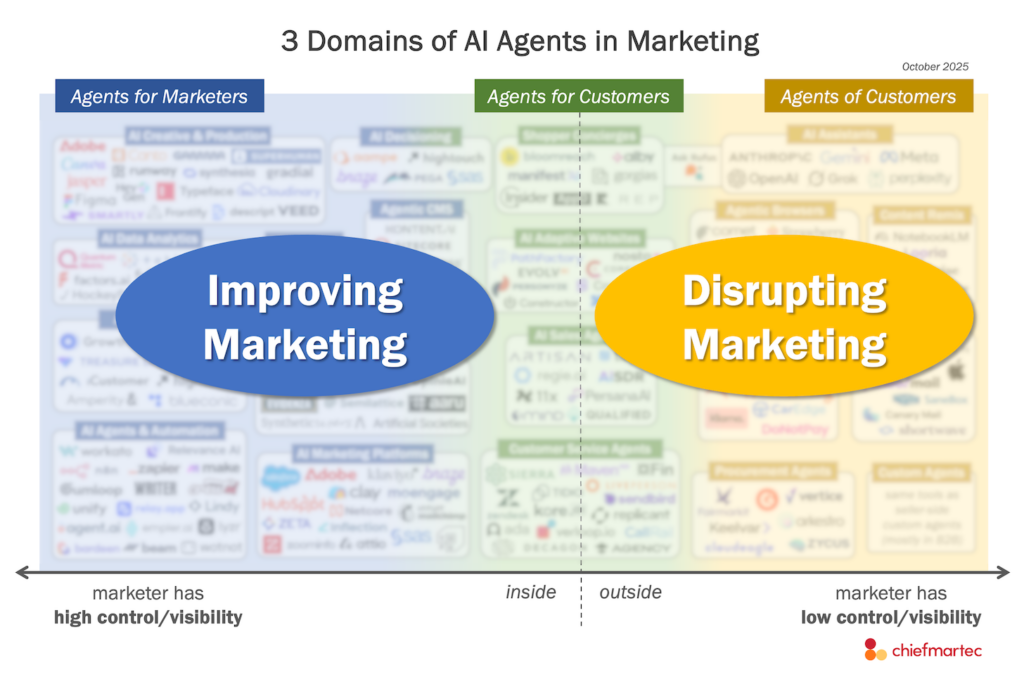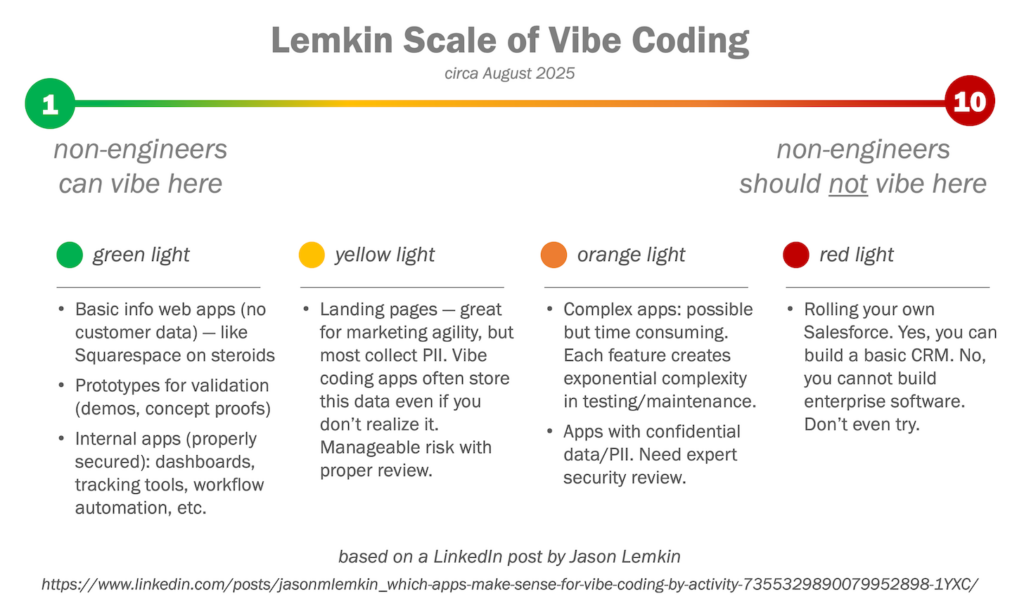
Yesterday, I moderated a panel on “the present and future of marketing automation” at MarketingProf’s B2B Forum with Atri Chatterjee, CMO of Act-On; Jon Miller, co-founder and VP marketing of Marketo; John Stetic, group VP products of Oracle Marketing Cloud; and You Mon Tsang, CEO of OutMarket (formerly the Vocus Marketing Cloud).
Dashing the hopes of those who attended the auto-race to see fiery crashes, there was little bloodsport — to the fine credit of the panelists. A little thinly-veiled sniping here and there, perhaps, but no chair throwing.
Instead, several interesting themes emerged as common ground in our session, echoing many of the points I heard from 9 chief marketing technologists at major brands in a CEB forum last month.
Open platforms have become the dominant strategy, yay
Act-On, Marketo, and Oracle all touted the strength of their ISV communities — to the point of jostling not merely about the number of third-parties in their ecosystems, but about the depth and simplicity of those integrations. Although they weren’t on the panel, I’ve heard and seen similar commitments to an open platform strategy from Adobe, HubSpot, IBM, and Salesforce.com.
(And there was much rejoicing.)
Jon Miller gave a kind shout out to my post on why 1,000 marketing technology vendors is the new normal in his remarks about Marketo’s vision for their platform as the “conductor” of a multi-player orchestra. It was his blog post back in April that I felt really triggered the marketing platform wars as a “thing” — although, in all fairness, both Act-On and Eloqua before the Oracle acquisition already had strong ISV programs too.
John Stetic gave a terrific example of how Dell had taken advantage of their platform’s open APIs to customize their solution and integrate with other third-party cloud services. This seemed right in line with what I heard last month at the CEB forum, where brands still wanted to differentiate their digital marketing experiences — but they wanted to build on top of a commercial infrastructure, rather than invent it all entirely from scratch. I think we’ll hear a lot more of these private ISV projects as success stories in the year ahead.
From marketing to full-lifecycle sales and service
Historically, most of the emphasis in marketing software has been on acquisition, and often just the work to win prospects up to the point of them becoming sales qualified leads (SQLs). Lead acquisition. Lead nurturing. Lead scoring. All roads led to leads (at least in B2B).
I found it remarkable that almost all of the panelists stressed how their platforms are now being used to better engage with customers after the sale too — to facilitate onboarding, improve customer success, raise retention rates, and grow accounts with subsequent upsells and cross-sells.
It makes perfect sense: for almost all businesses, it’s cheaper to invest in keeping an existing customer than it is to spend money on acquiring a new one. It buoys the net number of active customers and increases their lifetime value.
What’s interesting, however, is that this can rarely be tackled exclusively in the confines of the marketing department. Many more teams are involved. Yet having a marketing platform at the center of these initiatives further roots marketing as the “hub” around which other corporate functions coordinate their relationships with customers.
There’s some schizophrenia around CRMs
Discussing how these marketing platforms could help better align marketing and sales teams, breaking the illusion of a black-and-white “hand-off” of a lead from one to another, led me to ask: do you really need both a MAP and a CRM?
(Even mid-morning in downtown Boston, you could hear the crickets.)
Act-On and OutMarket, which both serve a lot of smaller businesses, were quick to point out that you didn’t — a number of their customers use only their software, with no separate CRM, to keep track of customers. I’d also note that HubSpot seems headed in this direction with their CRM product announcement last month too.
But Marketo and Oracle had a different point of view.
For most of the enterprises they work with, the CRM was already there before they arrived. It has been the system of record for the sales department, with considerable organizational inertia behind it. Aside from the technical challenges of migrating all of that data, and the organizational challenges of overhauling all of the related processes that are coordinated through that software today, it would face big political challenges too.
Sales doesn’t want marketing to control all of its data. It lives and dies by its numbers, and it wants to keep ownership of the system of record from which those numbers are tallied.
I get it. These human dimensions of our organizations are most resistant to change.
But increasingly, traditional CRM data seems like a filtered subset of the broader data that we have available in more advanced “marketing clouds.” Sure, salespeople want different views on that data, but that seems like small differences at the UI level. The benefits of seamlessly sharing data between sales and marketing in a real-time, two-way fashion strike me as becoming far more valuable than political jockeying over who owns their own system of record.
I’m the first to acknowledge that there’s benefit in specialized software for different needs and capabilities — it’s part of why the ISV ecosystems around these marketing platforms are thriving. But as an underlying system of record for customer interactions, I’m having a hard time seeing the difference between marketing and sales in this regard.
More importantly, I suspect that most customers don’t distinguish them much either.
At one point during the session, You Mon said he believed that “marketing will eat sales.” While I cautioned the audience (mostly marketers) that tweeting that remark might result in a chilly reception from their VP of sales when they got home, I think he’s right.
Not that I believe that sales and salespeople are going to become irrelevant — their direct interactions with customers may be fewer, but they’re still going to be incredibly important. Rather that sales will operate around the same centralized hub of customer experience management as everyone else in the business. And marketing will be at the center of that hub.
It would have been fun to have Salesforce.com on the panel to get their view. What’s yours?
Photo credit: Kate Klingman.




Scott,
You mon is partly right, marketing has already eaten sales, so it is just his tense that is wrong. Any reasonable review of customer behavior would show. marketing is pervasive throughout the whole sales cycle from the customer getting that first “itch” to after sales customer retention and lifetime value.
I like the term Marketo has brought into the conversation, “revenue generation” as the whole process, the split into marketing and sales and subsequent demarcation fisticuffs are now redundant.